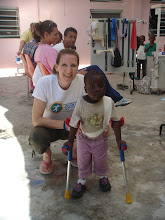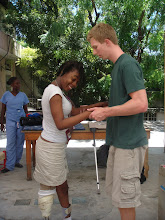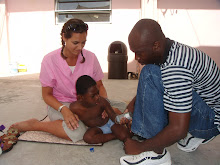It was on this day, that I felt compelled to write a quote from the Haitian-English Medical Phraseology text in my personal journal. The packet was left on the dresser by my bed to help us translate words like kanpe (“stand up”) and chita (“sit down”). These are the words, that after a few days of working at the Global Therapy Group clinic, I felt like I was beginning to comprehend: “You are here to offer hope to a people that has only too often resigned itself to death. The role of health care is to avoid or relieve suffering; there is more suffering here than in most places. “
Today was my first full day at the clinic. I loved seeing the patients—all of them. Their smiles were bigger, brighter and more numerous than I can remember seeing in one day…ever. My first patient of the day was a young girl with a club-foot deformity who needed a lift for her shoe, to help her compensate for a leg length discrepancy. I wondered if we would have anything in the supply closet that would give her the extra couple of inches that she needed. So, I went searching and found a cast shoe that was almost just the right height, one that she could use with different shoes and made her feel much better!
Trail Magic
About 10 years ago, I went backpacking on the Appalachian Trail, which traverses the mountains from Georgia to Maine, for about 5 months. On rare, surprising occasions, I was able to find exactly what I needed (or maybe just wanted)–such as a cooler full of sodas after hiking 15 miles or the tip for my walking stick to replace the one I wore out completely. This serendipity was coined “Trail Magic”. This is the feeling I had EVERY time I went up to the supply closet. Although the supplies were very loosely organized in some parts of the closet, my trips there always seemed divinely orchestrated and allowed me to provide AFOs, wheelchairs, cushions, canes, arm slings, air casts, splints, and elastic bands to my patients. At times, I might not have found exactly what I thought I needed, but was able to fabricate it, like an arm and wrist splint to fit my patient whose custom splint no longer fit his arm that was weakened by non-use following a stroke.
It seemed that so many of my patients following stroke had exceedingly weaker upper extremities than lower extremities. Not sure why that is. I think education on the concepts of learned non-use and the potential for neuroplasticity and recovery of function are ones that would benefit the patients and families, and possibly nurses and doctors.
The families have so much responsibility for their family member, from the moment he or she is admitted into the hospital and especially after the patient goes home. I had the pleasure of seeing one patient, Madame Marie Martha, from the day following her stroke in the hospital, and later in the clinic after she was discharged home. She was fortunate to have many family members helping her while she was in the hospital…3-4 different, genuinely caring, and concerned people in the room every day. The challenge for me was making sure everyone involved had the same education in order to provide the very best care for her. Everyone needed to know the precautions for protecting her arm during transfers, how to use the gait belt, and the importance of trying to encourage her to do as much for herself as possible during activities of daily living. Hope for recovery increasingly became a focal point of the family and patient education when I worked with patients following stroke. This made patients smile. I felt an increasing obligation to make sure I gave the best care possible so my patients had the best shot at regaining their lives.
Monday, May 9, 2011
Subscribe to:
Post Comments (Atom)

























No comments:
Post a Comment